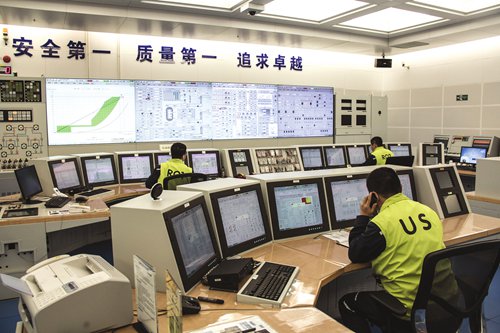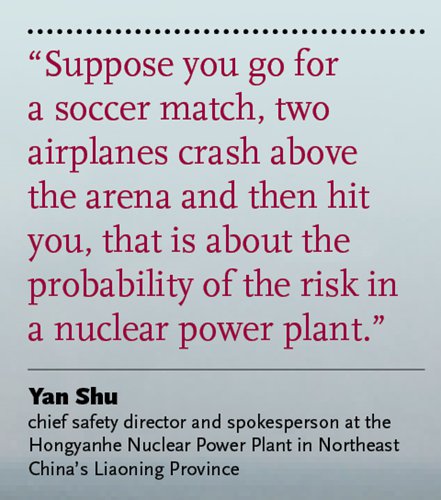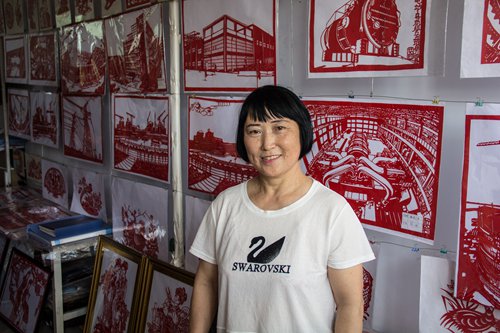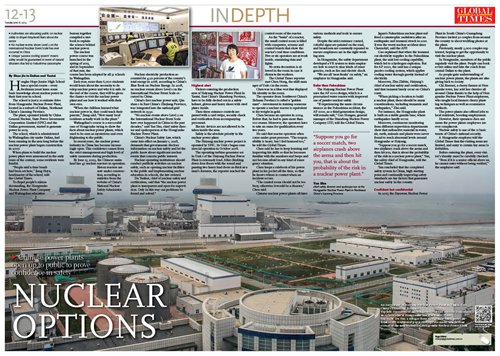Chinese nuclear power plants open up to public to prove confidence in safety
By Shan Jie in Dalian and Yantai Source:Global Times Published: 2019/6/17 18:53:40
○ Authorities are educating public on nuclear safety to dispel misplaced fears about the sector
○ No nuclear events above Level 2 on the International Nuclear Event Scale has ever occurred in China
○ Unique 'passive cooling system' means safety would be guaranteed in event of natural disasters that led to Fukushima catastrophe

The school is just a 10-minute drive from Hongyanhe Nuclear Power Plant, located in a suburb of Dalian, Northeast China's Liaoning Province.
The plant, operated jointly by China General Nuclear, State Power Investment Corporation Limited (SPIC) and the Dalian government, started to generate power in 2013.
The school, which is administered by Wafangdian city under Dalian, had been running in the area long before the nuclear power plant began construction in 2007.
When plans to build the nuclear power plant were announced in the early years of the century, some residents were fearful.
"People said a time bomb had been set here," Jiang Heyu, headmaster of the school, told the Global Times.
To dispel people's misunderstanding, the Hongyanhe Nuclear Power Plant Company and Wafangdian education bureau together compiled a textbook to explain the science behind nuclear power.
The nuclear power course was launched in the spring of 2013, and in September of that year, the course has been adopted by all 31 schools in Wafangdian.
Each year, more than 6,000 students would learn about the necessity to develop nuclear power and why it is safe. At the end of the course, they will be given the chance to visit the nuclear power plant and see how it worked with their own eyes.
"When the children learned what nuclear power is, they could teach their parents," Jiang said, "Now many local residents actually work in the plant."
Wafangdian's course is a successful case of Hongyanhe trying to show the facts about nuclear power plants, which used to be seen as mysterious and even frightening to the public.
In recent years, the nuclear power industry in China has become increasingly open. This confidence comes from the strict management and high level of safety measures during production.
By June 13, 2019, the Chinese mainland has 47 nuclear reactors in operation. Eleven reactors are now under construction, according to statistics from the website of China's National Nuclear Safety Administration.
Nuclear electricity production accounted for 4.22 percent of the country's total energy in 2018, according to China's Blue Book on Nuclear Energy. In 2018, no nuclear events above Level 1 on the International Nuclear Event Scale occurred in China.
China's first nuclear power unit, Qinshan 1 in East China's Zhejiang Province, was integrated into the national grid network in 1991.
"No nuclear events above Level 2 on the International Nuclear Event Scale have ever happened in China in the past decades," said Yan Shu, chief safety director and spokesperson at the Hongyanhe Nuclear Power Plant.
China's Nuclear Safety Law, which came into effect on January 1, 2018, demands that governments disclose information on nuclear safety and let the public know about significant nuclear events that concern public interest.
Nuclear operating institutions should conduct publicity activities on nuclear safety, such as opening nuclear facilities to the public and implementing nuclear education in schools, the law ordered.
Du Yanhui, chief of nuclear safety and certification, said that "the nuclear power plant is transparent and open for supervision. Only in this way can problems be found and solved."
Highest alert
Visitors entering the production area of Haiyang Nuclear Power Plant in Yantai, East China's Shandong Province, have to be fully decked out in a safety helmet, gloves and heavy shoes with steel plates inside.
Then three entrance controls are passed with a card swipe, security check and verification from accompanying personnel.
Electric devices are not allowed to be taken inside the area.
Safety is the absolute priority in the nuclear power plant.
The Haiyang nuclear power project is operated by SPIC. Its Unit 1 began commercial operation in October 2018.
The operating turbine generator set in Unit 1 of the Haiyang Nuclear Power Plant is extremely loud. After climbing down four floors with the sound and passing two heavy doors as thick as a man's forearm, the reporter reached the control room of the reactor.
As the "brain" of a reactor, the small control room is filled with computers, screens and control boards that show the reactor's real time conditions. Five or six operators are at work inside, examining data and lights.
No extra decoration is allowed in the room in case it distracts the workers.
The Global Times reporter met Chen Hong, the shift manager of Unit 1 in the room.
Chen was in a blue vest that displayed his identity in the room.
The operator from Southwest China's Sichuan Province is called a "golden man" - investment in training someone to operate a nuclear reactor is equivalent to his weight in gold.
Chen became an operator in 2015. Before that, he had to pass dozens of exams. Moreover, the operators have to take an exam for requalification every two years.

Chen said he has to keep learning and improving his skills so that he becomes familiar with the numbers and beeps and not become afraid in any kind of emergency situation.
Chen keeps a rulebook of his power plant in his pocket all the time, so that he knows whom to contact when an incident occurs.
"The control room should not be too busy, otherwise it would be a trouble," Chen said.
Chinese nuclear power plants all have various methods and tools to ensure safety.
Despite the strict entrance control, colorful signs are painted on the road, and broadcasts are constantly repeated to ensure employees are in the right working area.
In Hongyanhe, the safety department developed a VR system to train employees how to react to nine kinds of emergencies, such as fire and electric shock.
"We are all 'neat freaks' on safety," an employee in Hongyanhe said.
Safer than Fukushima
The Haiyang Nuclear Power Plant adopts Generation III pressurized water reactor technology with a passive safety system.
Guo Hongen, Vice President of Shandong Nuclear Power Company Ltd, told the Global Times that AP1000 is safer as the probability of a core meltdown and radioactivity release is 100 times lower compared to Generation II nuclear power plants.
Japan's Fukushima nuclear plant suffered a catastrophic meltdown after an earthquake and tsunami struck in 2011. It was the worst nuclear accident since Chernobyl, said the AFP.
Guo explained that when the tsunami cut electricity supplies in the Fukushima plant, the unit lost cooling capability, which led to a hydrogen explosion. But for AP 1000, the unit has a unique passive cooling system, which applies cooling water through gravity instead of electricity.
Moreover, Zhu Zhibin, Haiyang's chief of nuclear safety and licensing, said that tsunami barely occur on China's coast.
"When picking a location to build a nuclear plant, there should be many considerations, including tsunamis and earthquakes," Zhu said.
For instance, the Hongyanhe plant is built on a stable granite base, where earthquakes hardly occur.
Moreover, continuous monitoring from different supervision departments show that radioactive material in water, air, earth, animals and plants were never found to reach abnormal levels around Hongyanhe or Haiyang.

Yan concluded that the completed safety system in China, high starting point and continually improving safety standards are key factors that guarantee nuclear safety in the country.
Confident but confidential
In 2017, the Dayawan Nuclear Power Plant in South China's Guangdong Province invited 30 couples from around the country to shoot wedding photos at the plant.
Previously, nearly 3,000 couples registered, hoping to get the opportunity to visit the nuclear plant.
In Hongyanhe, members of the public regularly visit the plant. People can book a visit online and take the coach from central Dalian to the plant.
As people gain understanding of nuclear power plants, the plants are also giving back to society.
Chi Xuemei, a cherry farmer at Hongyanhe town, has sold her cherries all around China thanks to the help of Hongyanhe Nuclear Power Plant employees, who taught local farmers cherry planting techniques as well as ecommerce methods.

However, their openness does not mean the power plants employees are ever complacent.
Nuclear safety is one of the 11 basic tenets of China's national security.
A Hongyanhe employee told the Global Times that the visiting areas are limited, and entry to certain key areas is forbidden.
Before entering the plant, every visitor's identity must be carefully checked.
"Even if it is a senior official above us, he cannot enter without being verified," the employee said.

Newspaper headline: Nuclear options
○ No nuclear events above Level 2 on the International Nuclear Event Scale has ever occurred in China
○ Unique 'passive cooling system' means safety would be guaranteed in event of natural disasters that led to Fukushima catastrophe

An aerial view of Haiyang Nuclear Power Plant in Yantai, East China's Shandong Province Photo: Shan Jie/GT
Honghe Hope Junior High School has a special course - every freshman must learn some basic knowledge about nuclear power in their first year in school.The school is just a 10-minute drive from Hongyanhe Nuclear Power Plant, located in a suburb of Dalian, Northeast China's Liaoning Province.
The plant, operated jointly by China General Nuclear, State Power Investment Corporation Limited (SPIC) and the Dalian government, started to generate power in 2013.
The school, which is administered by Wafangdian city under Dalian, had been running in the area long before the nuclear power plant began construction in 2007.
When plans to build the nuclear power plant were announced in the early years of the century, some residents were fearful.
"People said a time bomb had been set here," Jiang Heyu, headmaster of the school, told the Global Times.
To dispel people's misunderstanding, the Hongyanhe Nuclear Power Plant Company and Wafangdian education bureau together compiled a textbook to explain the science behind nuclear power.
The nuclear power course was launched in the spring of 2013, and in September of that year, the course has been adopted by all 31 schools in Wafangdian.
Each year, more than 6,000 students would learn about the necessity to develop nuclear power and why it is safe. At the end of the course, they will be given the chance to visit the nuclear power plant and see how it worked with their own eyes.
"When the children learned what nuclear power is, they could teach their parents," Jiang said, "Now many local residents actually work in the plant."
Wafangdian's course is a successful case of Hongyanhe trying to show the facts about nuclear power plants, which used to be seen as mysterious and even frightening to the public.
In recent years, the nuclear power industry in China has become increasingly open. This confidence comes from the strict management and high level of safety measures during production.
By June 13, 2019, the Chinese mainland has 47 nuclear reactors in operation. Eleven reactors are now under construction, according to statistics from the website of China's National Nuclear Safety Administration.
Nuclear electricity production accounted for 4.22 percent of the country's total energy in 2018, according to China's Blue Book on Nuclear Energy. In 2018, no nuclear events above Level 1 on the International Nuclear Event Scale occurred in China.
China's first nuclear power unit, Qinshan 1 in East China's Zhejiang Province, was integrated into the national grid network in 1991.
"No nuclear events above Level 2 on the International Nuclear Event Scale have ever happened in China in the past decades," said Yan Shu, chief safety director and spokesperson at the Hongyanhe Nuclear Power Plant.
China's Nuclear Safety Law, which came into effect on January 1, 2018, demands that governments disclose information on nuclear safety and let the public know about significant nuclear events that concern public interest.
Nuclear operating institutions should conduct publicity activities on nuclear safety, such as opening nuclear facilities to the public and implementing nuclear education in schools, the law ordered.
Du Yanhui, chief of nuclear safety and certification, said that "the nuclear power plant is transparent and open for supervision. Only in this way can problems be found and solved."
Highest alert
Visitors entering the production area of Haiyang Nuclear Power Plant in Yantai, East China's Shandong Province, have to be fully decked out in a safety helmet, gloves and heavy shoes with steel plates inside.
Then three entrance controls are passed with a card swipe, security check and verification from accompanying personnel.
Electric devices are not allowed to be taken inside the area.
Safety is the absolute priority in the nuclear power plant.
The Haiyang nuclear power project is operated by SPIC. Its Unit 1 began commercial operation in October 2018.
The operating turbine generator set in Unit 1 of the Haiyang Nuclear Power Plant is extremely loud. After climbing down four floors with the sound and passing two heavy doors as thick as a man's forearm, the reporter reached the control room of the reactor.
As the "brain" of a reactor, the small control room is filled with computers, screens and control boards that show the reactor's real time conditions. Five or six operators are at work inside, examining data and lights.
No extra decoration is allowed in the room in case it distracts the workers.
The Global Times reporter met Chen Hong, the shift manager of Unit 1 in the room.
Chen was in a blue vest that displayed his identity in the room.
The operator from Southwest China's Sichuan Province is called a "golden man" - investment in training someone to operate a nuclear reactor is equivalent to his weight in gold.
Chen became an operator in 2015. Before that, he had to pass dozens of exams. Moreover, the operators have to take an exam for requalification every two years.

Operators of nuclear power reactors train on a simulator in a classroom at Hongyanhe Nuclear Power Plant. Photo: Shan Jie/GT
He said that reactor operators often come under great pressure. "The responsibility is heavy, but I feel honored too," he told the Global Times.Chen said he has to keep learning and improving his skills so that he becomes familiar with the numbers and beeps and not become afraid in any kind of emergency situation.
Chen keeps a rulebook of his power plant in his pocket all the time, so that he knows whom to contact when an incident occurs.
"The control room should not be too busy, otherwise it would be a trouble," Chen said.
Chinese nuclear power plants all have various methods and tools to ensure safety.
Despite the strict entrance control, colorful signs are painted on the road, and broadcasts are constantly repeated to ensure employees are in the right working area.
In Hongyanhe, the safety department developed a VR system to train employees how to react to nine kinds of emergencies, such as fire and electric shock.
"We are all 'neat freaks' on safety," an employee in Hongyanhe said.
Safer than Fukushima
The Haiyang Nuclear Power Plant adopts Generation III pressurized water reactor technology with a passive safety system.
Guo Hongen, Vice President of Shandong Nuclear Power Company Ltd, told the Global Times that AP1000 is safer as the probability of a core meltdown and radioactivity release is 100 times lower compared to Generation II nuclear power plants.
Japan's Fukushima nuclear plant suffered a catastrophic meltdown after an earthquake and tsunami struck in 2011. It was the worst nuclear accident since Chernobyl, said the AFP.
Guo explained that when the tsunami cut electricity supplies in the Fukushima plant, the unit lost cooling capability, which led to a hydrogen explosion. But for AP 1000, the unit has a unique passive cooling system, which applies cooling water through gravity instead of electricity.
Moreover, Zhu Zhibin, Haiyang's chief of nuclear safety and licensing, said that tsunami barely occur on China's coast.
"When picking a location to build a nuclear plant, there should be many considerations, including tsunamis and earthquakes," Zhu said.
For instance, the Hongyanhe plant is built on a stable granite base, where earthquakes hardly occur.
Moreover, continuous monitoring from different supervision departments show that radioactive material in water, air, earth, animals and plants were never found to reach abnormal levels around Hongyanhe or Haiyang.

"Suppose you go for a soccer match, two airplanes crash above the arena and then hit you, that is about the probability of the risk in a nuclear power plant," Yan, the safety chief of Hongyanhe, told the Global Times.
Yan concluded that the completed safety system in China, high starting point and continually improving safety standards are key factors that guarantee nuclear safety in the country.
Confident but confidential
In 2017, the Dayawan Nuclear Power Plant in South China's Guangdong Province invited 30 couples from around the country to shoot wedding photos at the plant.
Previously, nearly 3,000 couples registered, hoping to get the opportunity to visit the nuclear plant.
In Hongyanhe, members of the public regularly visit the plant. People can book a visit online and take the coach from central Dalian to the plant.
As people gain understanding of nuclear power plants, the plants are also giving back to society.
Chi Xuemei, a cherry farmer at Hongyanhe town, has sold her cherries all around China thanks to the help of Hongyanhe Nuclear Power Plant employees, who taught local farmers cherry planting techniques as well as ecommerce methods.

Du Yan, a villager from Hongyanhe town, poses in front of the traditional paper cuttings she made, which show scenes of the non-traditional Hongyanhe Nuclear Power Plant. Photo: Shan Jie/GT
The power plants also offered jobs to local residents, boosting employment.However, their openness does not mean the power plants employees are ever complacent.
Nuclear safety is one of the 11 basic tenets of China's national security.
A Hongyanhe employee told the Global Times that the visiting areas are limited, and entry to certain key areas is forbidden.
Before entering the plant, every visitor's identity must be carefully checked.
"Even if it is a senior official above us, he cannot enter without being verified," the employee said.

Newspaper headline: Nuclear options